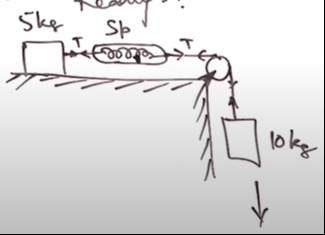Question
Question: The question is incomplete as it does not specify what needs to be calculated. However, assuming a t...
The question is incomplete as it does not specify what needs to be calculated. However, assuming a typical problem setup for JEE/NEET exams based on the provided diagram, we will calculate the tension in the string and the acceleration of the masses when the system is released from rest with the spring at its natural length.
Assumptions:
- The horizontal surface is frictionless.
- The pulley is frictionless and massless.
- The spring is ideal (massless, obeys Hooke's Law).
- The system is released from rest, and the spring is initially at its natural length.
Interpretation of the Diagram: Based on the labels and arrows, the most plausible interpretation is:
- Mass m1=5kg is on a frictionless horizontal surface.
- Mass m2=10kg is hanging vertically.
- A string connects m1 to the pulley. The string passes over the pulley.
- The other end of the string is attached to m2.
- A spring "Sp" is connected between m1 and the pulley.
Let a be the acceleration of m1 to the right and m2 downwards. The tension in the string is T. Let k be the spring constant.
Analysis of Forces:
-
For mass m2 (10kg): The forces acting on m2 are its weight (m2g) acting downwards and the tension (T) acting upwards. Applying Newton's second law: m2g−T=m2a 10g−T=10a (Equation 1)
-
For mass m1 (5kg): The forces acting on m1 are the tension (T) pulling it to the right, and the force exerted by the spring (Fsp) pulling it to the left (assuming the spring is extended). Applying Newton's second law: T−Fsp=m1a T−Fsp=5a (Equation 2)
-
Spring Force (Fsp): The spring is connected between m1 and the pulley. Assuming the pulley is fixed, the extension of the spring (x) is equal to the displacement of m1 from its equilibrium position. The spring force is given by Hooke's Law: Fsp=kx.
Solving for Acceleration and Tension (Initial State): When the system is released from rest with the spring at its natural length, the initial extension x=0, so Fsp=k×0=0. Equation 2 becomes: T−0=5a T=5a
Substitute this into Equation 1: 10g−(5a)=10a 10g=15a a=1510g=32g
Now, find the tension T: T=5a=5×32g=310g
Using g≈9.8m/s2 or g≈10m/s2: If g≈10m/s2: a=32×10=320m/s2≈6.67m/s2 T=310×10=3100N≈33.3N
If g≈9.8m/s2: a=32×9.8=319.6m/s2≈6.53m/s2 T=310×9.8=398N≈32.67N
Since no specific question or options are provided, we cannot select an answer. However, the derived values for acceleration and tension are standard results for this type of problem.

The question is incomplete. Based on standard interpretations, the initial acceleration of the system is a=32g and the initial tension in the string is T=310g.
Solution
The problem describes a system of two masses connected by a string over a pulley and a spring. Assuming the system is released from rest with the spring at its natural length, we apply Newton's second law to each mass. The tension in the string is the same throughout. The spring force acts on the 5kg mass and the pulley. For the initial moment, the spring force is zero. This allows us to set up two equations with two unknowns (tension T and acceleration a), which are then solved.
